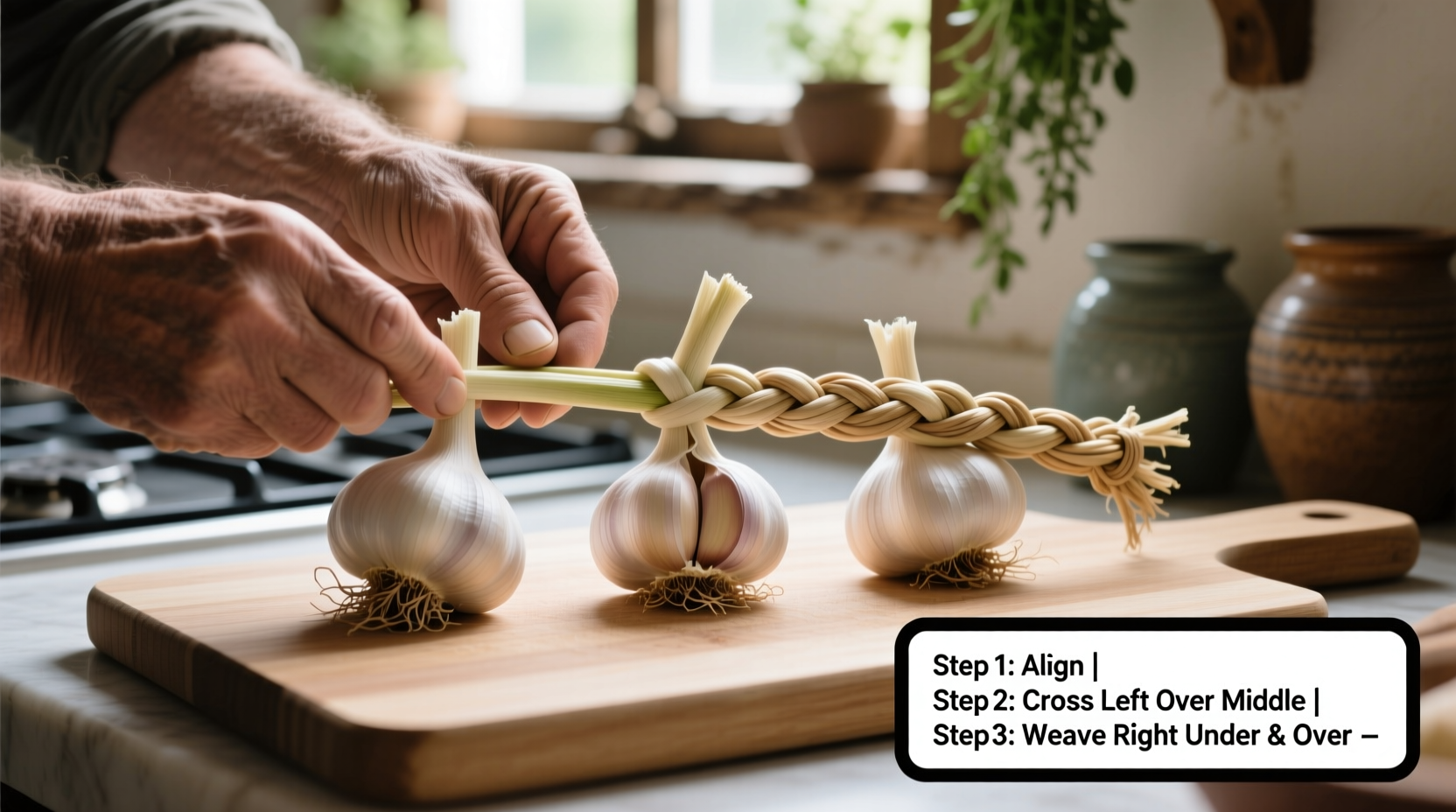Garlic braiding isn't just practical—it connects you to centuries of culinary tradition. As a preservation method dating back to ancient Mediterranean cultures, braiding allows home growers to store their harvest without refrigeration while adding rustic charm to any kitchen. Whether you're preserving your garden bounty or creating thoughtful handmade gifts, mastering this simple technique ensures your garlic maintains peak flavor and freshness.
What You'll Need Before Starting
Selecting the right garlic makes all the difference in your braiding success. Hardneck varieties with sturdy stalks work best for braiding, while softneck types offer longer storage potential. Here's how to choose wisely:
| Garlic Type | Braiding Suitability | Storage Duration | Best Harvest Time |
|---|---|---|---|
| Rocambole | Excellent (sturdy stalks) | 6-7 months | Early summer |
| Purple Stripe | Very Good | 7-8 months | Mid-summer |
| Porcelain | Good | 5-6 months | Late summer |
| Softneck | Fair (flexible stalks) | 9-12 months | Late summer |
According to the USDA Agricultural Research Service, hardneck garlic varieties contain higher allicin levels which provide superior health benefits compared to softneck types. For optimal braiding results, harvest when approximately one-third of the leaves have turned brown—a signal that bulb development is complete but before cloves begin separating.
Step-by-Step Braiding Process
Timing is critical for successful garlic braiding. The National Center for Home Food Preservation recommends working with garlic within 2-3 weeks after harvest when stalks remain flexible but bulbs have cured sufficiently. Follow these professional steps:
- Prepare your garlic: Gently brush off excess dirt (don't wash), then cure in a dark, well-ventilated area for 2-3 weeks until outer skins are papery. Trim roots to ¼ inch and remove loose outer wrappers while preserving protective layers.
- Create your base: Select three large, similarly sized bulbs to form your foundation. Position them in a triangular formation with stems aligned. Secure stems together 2 inches below bulbs using kitchen twine.
- Begin the braid: Divide remaining garlic into three equal portions. Start braiding the stems as you would hair, adding one clove to each strand every 2-3 inches. Always add cloves to the outside of each strand for secure placement.
- Maintain consistent tension: Keep moderate pressure on the braid—too tight crushes bulbs, too loose creates gaps. Professional growers recommend checking tension every 5-6 cloves by gently tugging on the structure.
- Complete your braid: When you've added all cloves, continue braiding the remaining 6-8 inches of stem. Secure the end with twine and tuck the tail underneath for a clean finish.

Troubleshooting Common Braiding Problems
Even experienced gardeners encounter challenges when learning how to braid garlic properly. Here's how to handle frequent issues:
- Stems breaking during braiding: This indicates improper curing. University of Minnesota Extension specialists recommend that ideal braiding stems should bend without snapping. If stems break frequently, your garlic needs 3-5 more days of curing.
- Loose or uneven braid: Maintain consistent tension by working on a flat surface and measuring each addition point. Professional braiders use a simple trick: place a ruler alongside your work to ensure even spacing between added cloves.
- Mold development during storage: This occurs when garlic wasn't sufficiently cured before braiding. The National Center for Home Food Preservation states that proper curing requires 21-30 days in temperatures between 75-85°F with 70-80% humidity.
Storage and Usage Guidelines
Properly braided garlic stored in a cool, dark place with good air circulation will maintain quality for 6-9 months. Avoid these common storage mistakes:
- Don't store near heat sources like stoves or ovens
- Avoid direct sunlight which causes sprouting
- Never refrigerate whole bulbs (causes premature sprouting)
- Don't remove protective wrappers until ready to use
When using braided garlic, work from the bottom up, removing cloves as needed while preserving the braid's integrity. For cooking, remember that roasted garlic from braids develops a richer, sweeter flavor than store-bought varieties due to the natural curing process.
Creative Applications for Braided Garlic
Beyond practical storage, garlic braids serve multiple purposes in the kitchen and home:
- Kitchen decor: Hang braids near your cooking area for both beauty and convenience
- Thoughtful gifts: Add dried herbs or decorative ribbons for special occasions
- Garden markers: Use smaller braids to identify vegetable varieties in your garden
- Recipe enhancement: Braid includes both large outer cloves and smaller inner ones, perfect for different culinary applications
Frequently Asked Questions
Here are answers to the most common questions about garlic braiding:











 浙公网安备
33010002000092号
浙公网安备
33010002000092号 浙B2-20120091-4
浙B2-20120091-4